Gas Transportation Device
MOU; Hao-Jan ; et al.
U.S. patent application number 16/058108 was filed with the patent office on 2019-02-28 for gas transportation device. This patent application is currently assigned to Microjet Technology Co., Ltd.. The applicant listed for this patent is Microjet Technology Co., Ltd.. Invention is credited to Shih-Chang CHEN, Yung-Lung HAN, Che-Wei HUANG, Chi-Feng HUANG, Hao-Jan MOU, Chun-Lung TSENG, Chien-Tang WEN.
| Application Number | 20190063423 16/058108 |
| Document ID | / |
| Family ID | 63174101 |
| Filed Date | 2019-02-28 |
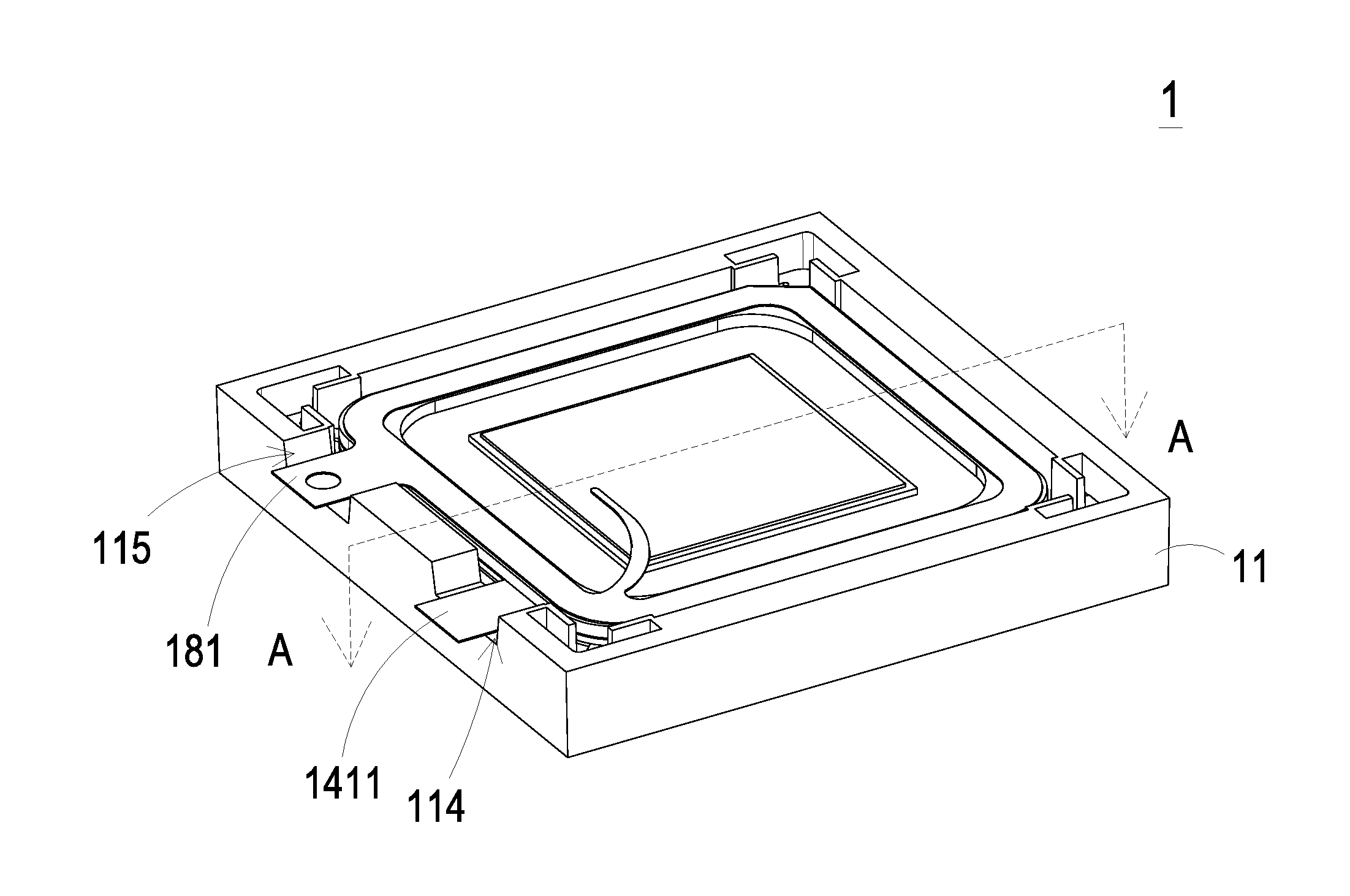
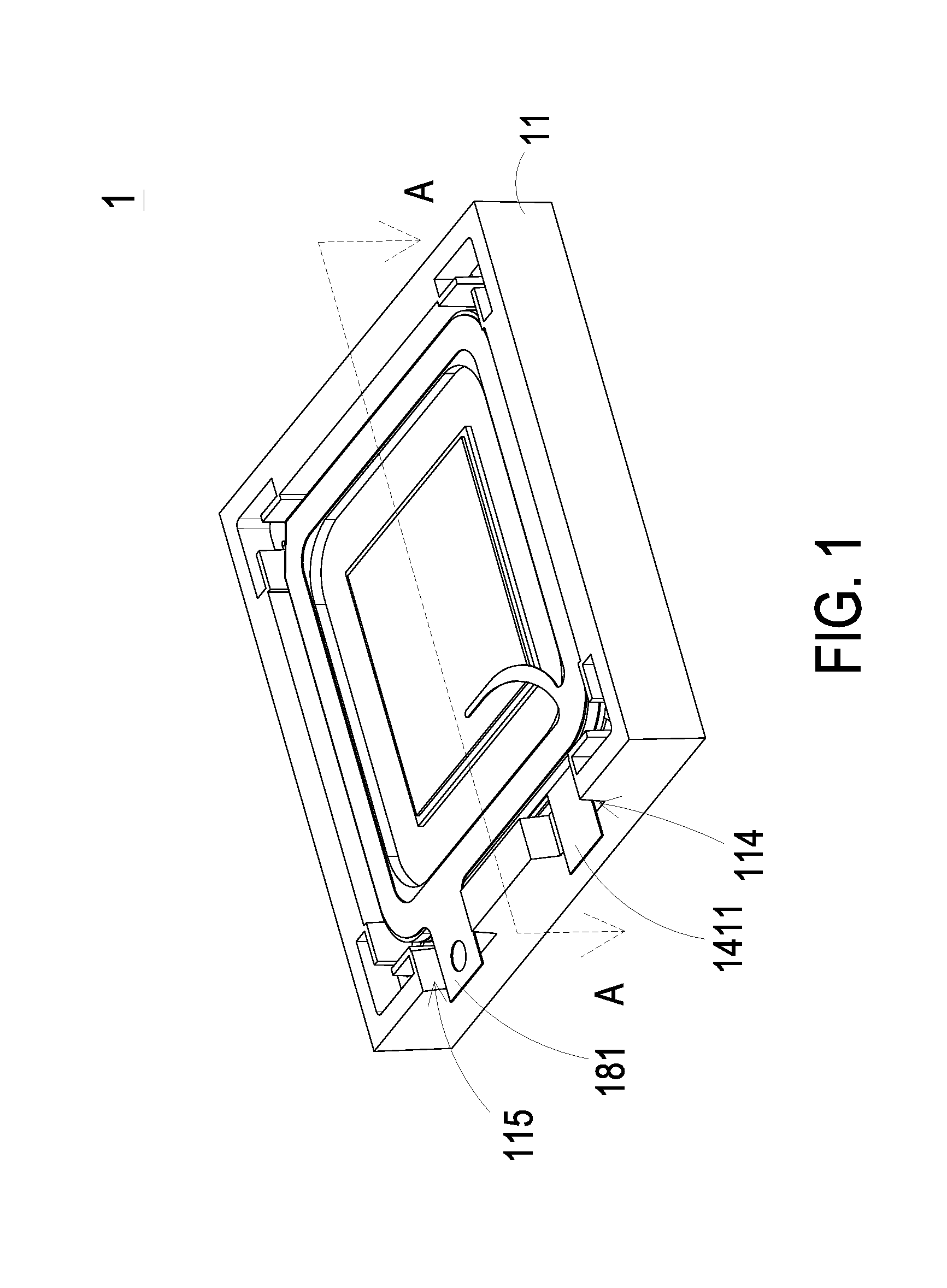
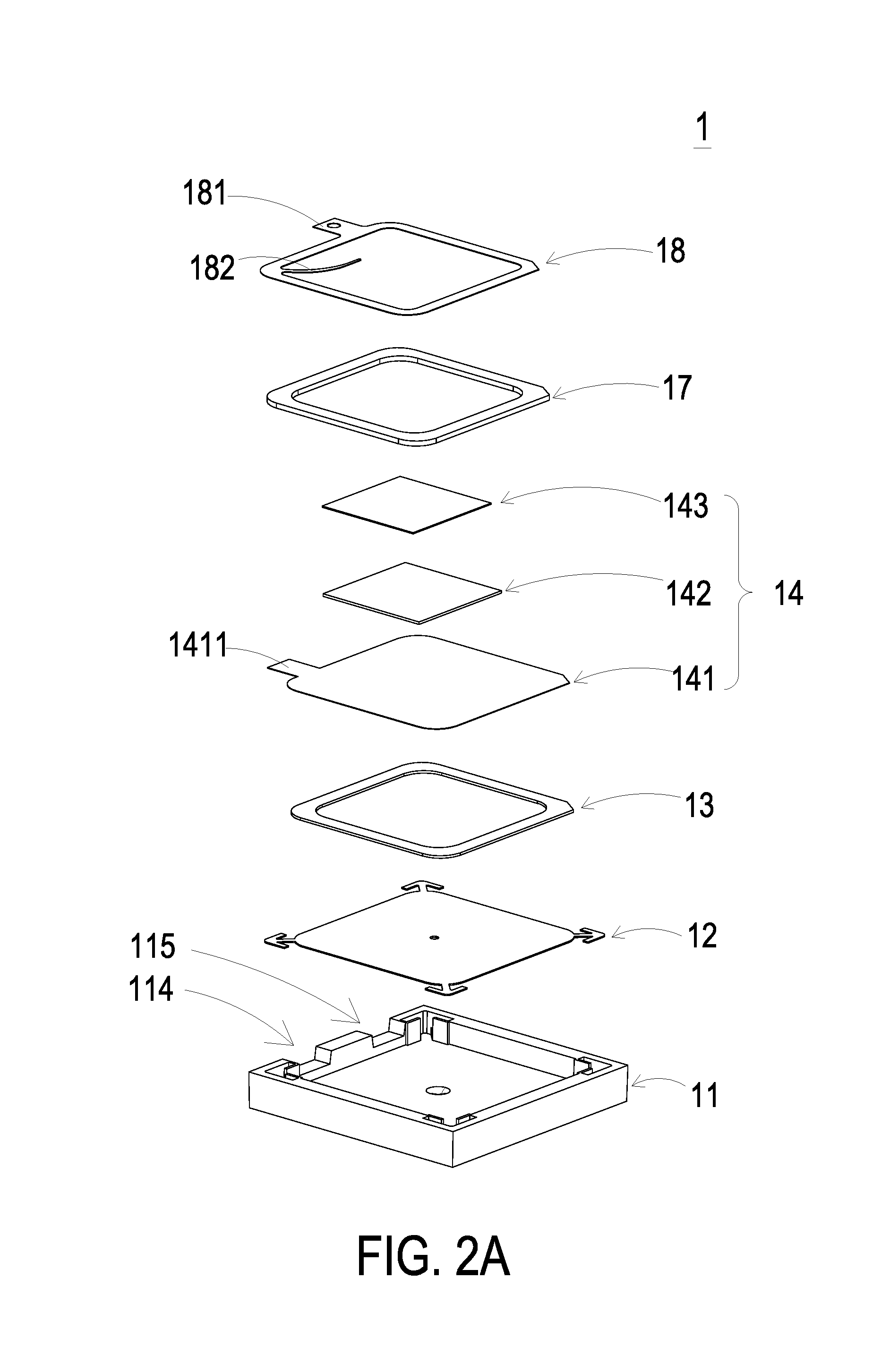



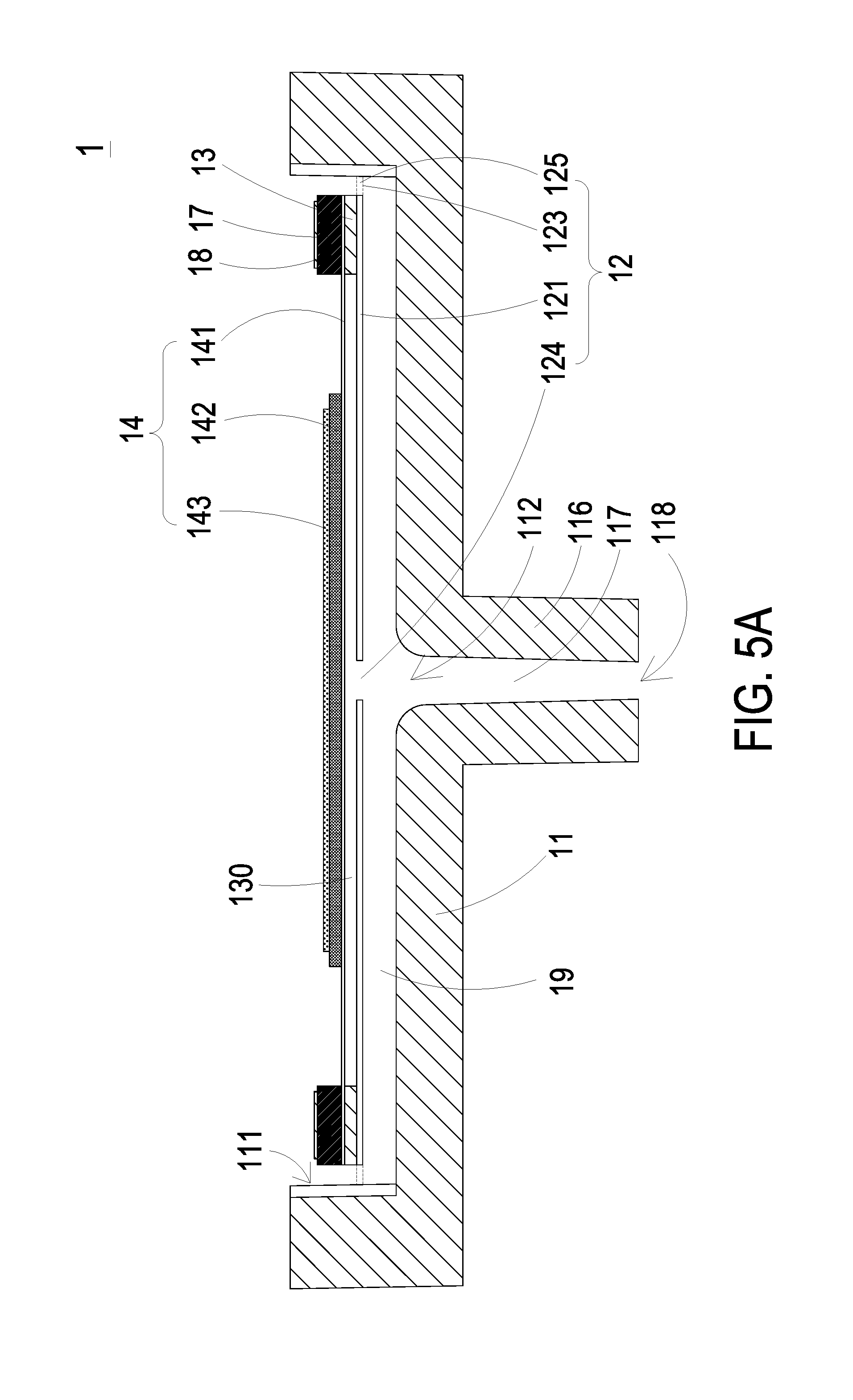
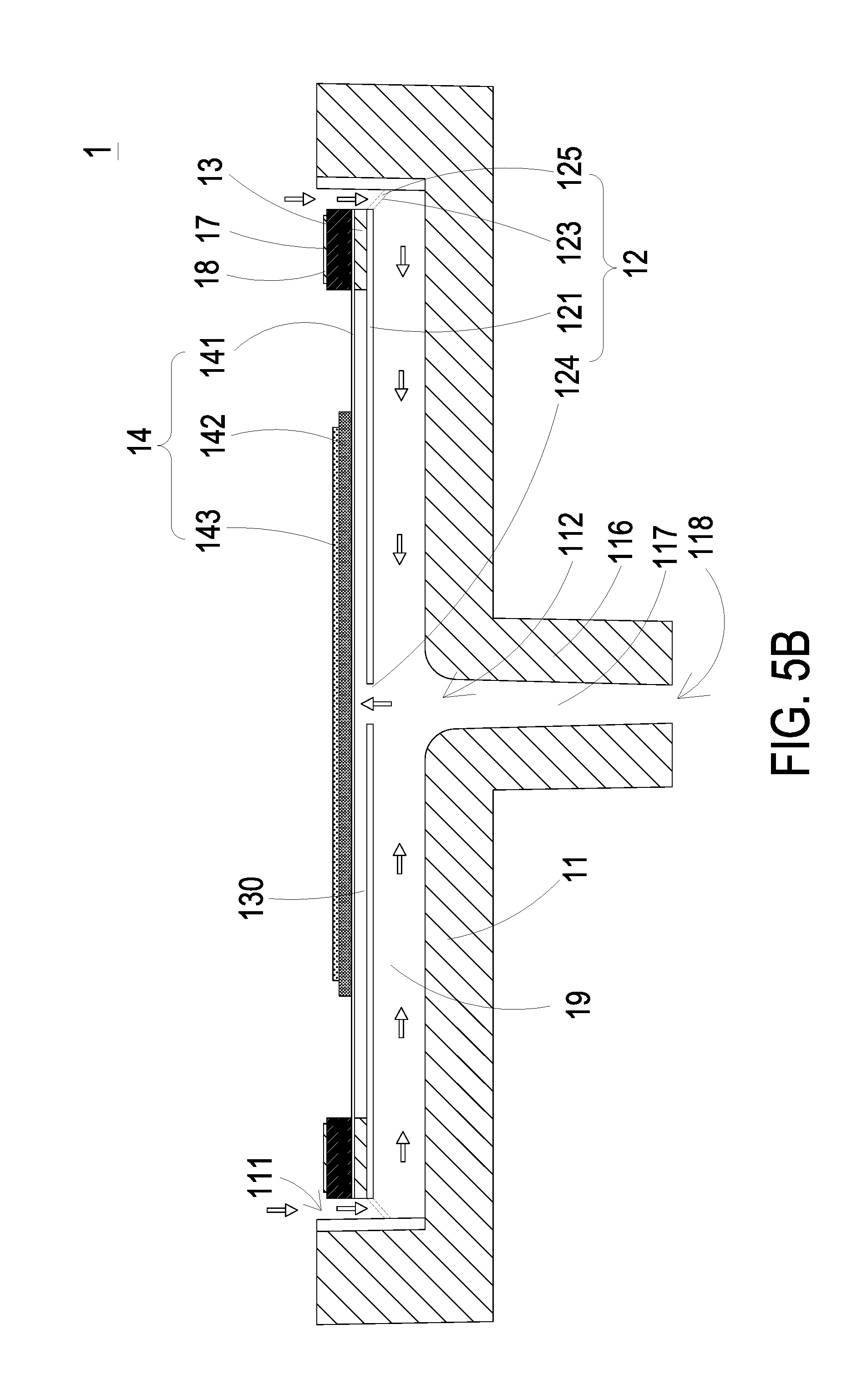
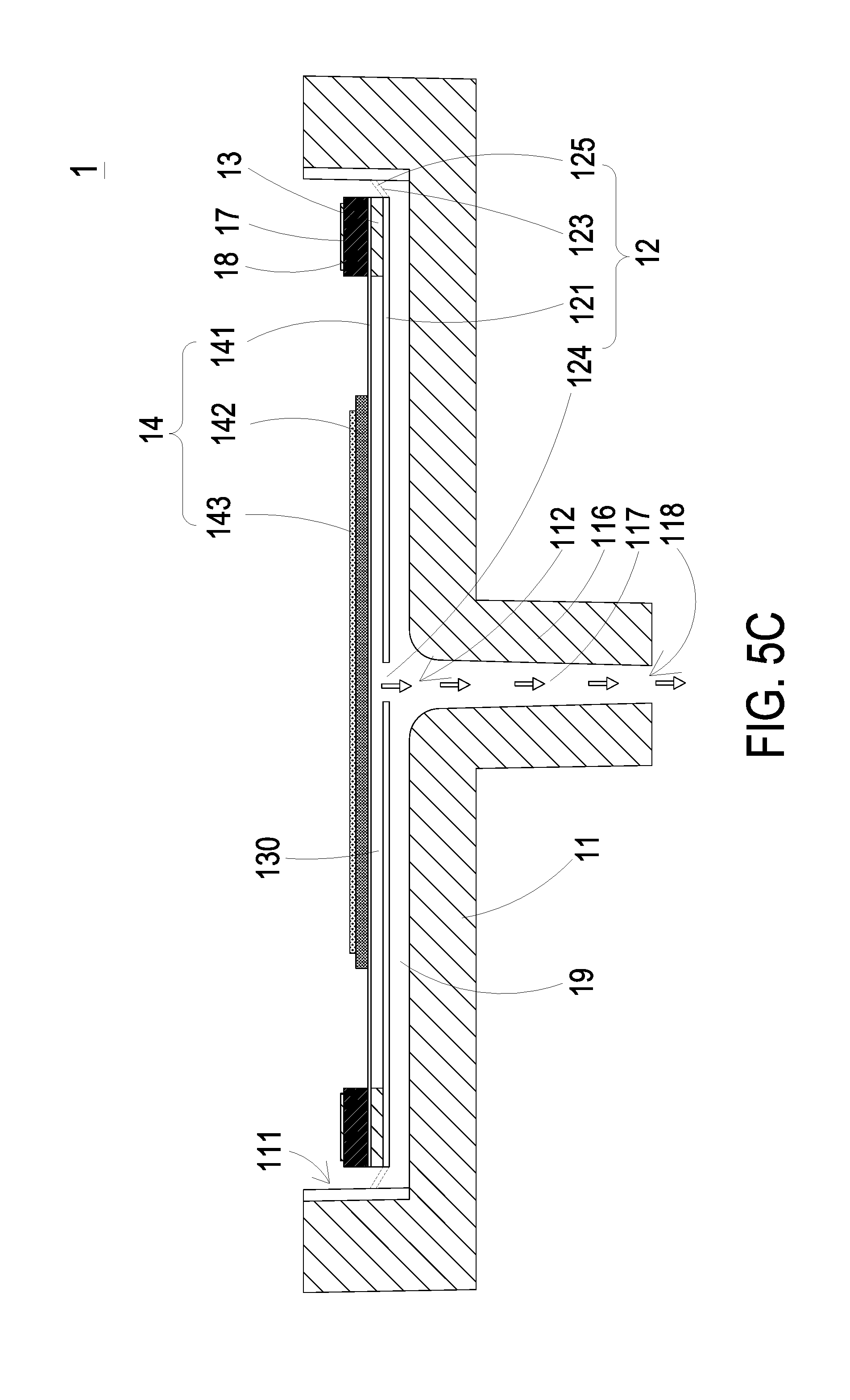
| United States Patent Application | 20190063423 |
| Kind Code | A1 |
| MOU; Hao-Jan ; et al. | February 28, 2019 |
GAS TRANSPORTATION DEVICE
Abstract
A gas transportation device includes a casing, a nozzle plate, a chamber frame, an actuator, an insulating frame and a conducting frame, which are stacked sequentially. A resonance chamber is defined by the actuator, the chamber frame and the suspension plate collaboratively. When the actuator is enabled, the nozzle plate is subjected to resonance and the suspension plate of the nozzle plate vibrates in the reciprocating manner. Consequently, the gas is transferred to a gas-guiding chamber through the at least one vacant space and discharged from the discharging opening and the gas is circulated.
| Inventors: | MOU; Hao-Jan; (Hsinchu, TW) ; TSENG; Chun-Lung; (Hsinchu, TW) ; HUANG; Che-Wei; (Hsinchu, TW) ; WEN; Chien-Tang; (Hsinchu, TW) ; CHEN; Shih-Chang; (Hsinchu, TW) ; HAN; Yung-Lung; (Hsinchu, TW) ; HUANG; Chi-Feng; (Hsinchu, TW) | ||||||||||
| Applicant: |
|
||||||||||
|---|---|---|---|---|---|---|---|---|---|---|---|
| Assignee: | Microjet Technology Co.,
Ltd. Hsinchu TW |
||||||||||
| Family ID: | 63174101 | ||||||||||
| Appl. No.: | 16/058108 | ||||||||||
| Filed: | August 8, 2018 |
| Current U.S. Class: | 1/1 |
| Current CPC Class: | F04B 39/121 20130101; F04B 39/123 20130101; F04B 45/047 20130101; F04B 43/04 20130101 |
| International Class: | F04B 45/047 20060101 F04B045/047 |
Foreign Application Data
| Date | Code | Application Number |
|---|---|---|
| Aug 31, 2017 | TW | 106129720 |
Claims
1. A gas transportation device for transferring gas, comprising: a casing comprising at least one fixing recess, an accommodation space and a discharging opening, wherein the accommodation space has a bottom surface; a nozzle plate comprising at least one bracket, a suspension plate and a through hole, wherein the suspension plate is permitted to undergo bending vibration, and the at least one bracket is accommodated within the at least fixing recess so as to positionally accommodate the nozzle plate within the accommodation space and a gas-guiding chamber is defined between the nozzle plate and the bottom surface of the accommodation space, wherein the gas-guiding chamber is in communication with the discharging opening, and at least one vacant space is formed between the at least one bracket, the suspension plate and the casing; a chamber frame stacked on and supported by the suspension plate; an actuator stacked on and supported by the chamber frame, wherein in response to a voltage applied to the actuator, the actuator undergoes the bending vibration in a reciprocating manner; an insulating frame stacked on and supported by the actuator; and a conducting frame stacked on and supported by the insulating frame, wherein a resonance chamber is defined by the actuator, the chamber frame and the suspension plate collaboratively, and wherein when the actuator is enabled, the nozzle plate is subjected to resonance and the suspension plate of the nozzle plate vibrates in the reciprocating manner, so that the gas is transferred to the gas-guiding chamber through the at least one vacant space and discharged from the discharging opening, whereby the gas is circulated therein and transferred out.
2. The gas transportation device according to claim 1, wherein the bracket comprises a fixing part and a connecting part, wherein a shape of the fixing part matches a shape of the fixing recess, and the connecting part is connected between the suspension plate and the fixing part, wherein the connecting part is elastic and the suspension plate is supported by the connecting part, so that the suspension plate undergoes the bending vibration in the reciprocating manner.
3. The gas transportation device according to claim 2, wherein the shape of the fixing part is L-shaped, and the shape of the fixing recess is L-shaped.
4. The gas transportation device according to claim 1, wherein the accommodation space has one of a square profile, a circular profile, an elliptic profile, a triangular profile and a polygonal profile.
5. The gas transportation device according to claim 1, wherein the suspension plate has one of a square profile, a circular profile, an elliptic profile, a triangular profile and a polygonal profile.
6. The gas transportation device according to claim 1, wherein the actuator comprises: a carrier plate stacked on and supported by the chamber frame; an adjusting resonance plate stacked on and supported by the carrier plate; and a piezoelectric plate stacked on and supported by the adjusting resonance plate, wherein when the voltage is applied to the piezoelectric plate, the carrier plate and the adjusting resonance plate undergo the bending vibration in the reciprocating manner.
7. The gas transportation device according to claim 6, wherein a thickness of the adjusting resonance plate is thicker than a thickness of the carrier plate.
8. The gas transportation device according to claim 6, wherein the carrier plate comprises a first conducting pin, and the casing comprises a first notch disposed for positioning the first conducting pin of the carrier plate, wherein the first conducting pin of the carrier plate protrudes outside the casing through the first notch.
9. The gas transportation device according to claim 6, wherein the conducting frame comprises a second conducting pin and an electrode, and the electrode is electrically connected to the piezoelectric plate.
10. The gas transportation device according to claim 9, wherein the casing further comprises a second notch disposed for positioning the second conducting pin of the conducting frame, wherein the second conducting pin of the conducting frame protrudes outside the casing through the second notch.
11. The gas transportation device according to claim 6, wherein a vibration frequency of the piezoelectric plate is in a range between the 10 KHz and 30 KHz.
12. The gas transportation device according to claim 1, wherein the casing has a conduit protruding outwardly from the discharging opening of the casing, and the conduit comprises a channel part and an outlet, wherein the channel part is in communication with the accommodation space through the discharging opening, and the channel part is in communication with an environment outside the casing through the outlet.
13. The gas transportation device according to claim 12, wherein the channel part has a cone shape and is tapered from an end proximate to the discharging opening to the other end proximate to the outlet.
14. The gas transportation device according to claim 12, wherein a diameter of the discharging opening is in a range between 0.85 mm and 1.25 mm, and a diameter of the outlet is in a range between 0.8 mm and 1.2 mm.
15. The gas transportation device according to claim 6, wherein a thickness of the carrier plate is in a range between 0.04 mm and 0.06 mm.
16. The gas transportation device according to claim 6, wherein a thickness of the adjusting resonance plate is in a range between 0.1 mm and 0.3 mm.
17. The gas transportation device according to claim 6, wherein a thickness of the piezoelectric plate is in a range between 0.05 mm and 0.15 mm.
18. The gas transportation device according to claim 1, wherein a height of the gas-guiding chamber is in a range between the 0.2 mm and 0.8 mm.
19. The gas transportation device according to claim 1, wherein a capacity of the resonance chamber is in a range between 6.3 cubic millimeters and 186 cubic millimeters.
20. A gas transportation device for transferring gas, comprising: at least one casing comprising at least one fixing recess, at least one accommodation space and at least one discharging opening, wherein the accommodation space has a bottom surface; at least one nozzle plate comprising at least one bracket, at last one suspension plate and at least one through hole, wherein the suspension plate is permitted to undergo bending vibration, and the at least one bracket is accommodated within the at least fixing recess, so as to positionally accommodate the nozzle plate within the accommodation space and at least one gas-guiding chamber is defined between the nozzle plate and the bottom surface of the accommodation space, wherein the gas-guiding chamber is in communication with the discharging opening, and at least one vacant space is formed between the at least one bracket, the suspension plate and the casing; at least one chamber frame stacked on and supported by the suspension plate; at least one actuator stacked on and supported by the chamber frame, wherein in response to a voltage applied to the actuator, the actuator undergoes the bending vibration in a reciprocating manner; at least one insulating frame stacked on and supported by the actuator; and at least one conducting frame stacked on and supported by the insulating frame, wherein at least one resonance chamber is defined by the actuator, the chamber frame and the nozzle plate collaboratively, and wherein when the actuator is enabled, the nozzle plate is subjected to resonance and the suspension plate of the nozzle plate vibrates in the reciprocating manner, so that the gas is transferred to the gas-guiding chamber through the at least one vacant space and discharged from the discharging opening, whereby the gas is circulated therein and transferred out.
Description
FIELD OF THE INVENTION
[0001] The present disclosure relates to a gas transportation device, and more particularly to a miniature and silent gas transportation device for transferring gas at a high speed.
BACKGROUND OF THE INVENTION
[0002] In various fields such as pharmaceutical industries, computer techniques, printing industries or energy industries, the products are developed toward elaboration and miniaturization. The fluid transportation devices are important components that are used in for example micro pumps, micro atomizers, printheads or industrial printers. Therefore, it is important to provide an improved structure of the fluid transportation device.
[0003] With the rapid development of technology, the applications of gas transportation devices are becoming more and more diversified. For example, gas transportation devices are gradually popular in industrial applications, biomedical applications, medical care applications, heat dissipation applications, or even the wearable devices. It is obvious that the trends of designing gas transportation devices are toward the miniature structure and the larger flowrate.
[0004] In accordance with the existing technologies, the gas transportation device is assembled by stacking plural conventional mechanical parts. For achieving the miniature and slim benefits of the overall device, all mechanical parts are minimized or thinned. However, since the individual mechanical part is minimized, it is difficult to the control the size precision and the assembling precision. Consequently, the product yield is low and inconsistent, or even the flowrate of the gas is not stable. Moreover, as the conventional gas transportation device is employed, since the discharged gas fails to be effectively converged or the component size is very small, the force of pushing the gas is usually insufficient. Accordingly, the amount of the gas transferred by the gas transportation device is low.
[0005] Therefore, there is a need of providing a miniature fluid transportation device applied in various devices to make the apparatus or the equipment which need to equip with the fluid transportation device achieve small-size, miniature and silent benefits in order to eliminate the above drawbacks.
SUMMARY OF THE INVENTION
[0006] An object of the present disclosure provides a gas transportation device with a special fluid channel and a nozzle plate. The gas transportation device is small, miniature and silent and has enhanced size precision.
[0007] Another object of the present disclosure provides a gas transportation device with a cuboidal resonance chamber and a special conduit. A Helmholtz resonance effect is produced by a piezoelectric plate and the cuboidal resonance chamber. Consequently, a great amount of gas is converged and transferred at a high speed. The converged gas is in the ideal fluid state complying with the Bernoulli's principle. Therefore, the drawback of the prior art that the amount of the gas transportation is low is solved.
[0008] In accordance with an aspect of the present disclosure, a gas transportation device is provided for transferring gas. The gas transportation device includes a casing, a nozzle plate, a chamber frame, an actuator, an insulating frame and a conducting frame. The casing includes at least one fixing recess, an accommodation space and a discharging opening. The accommodation space has a bottom surface. The nozzle plate includes at least one bracket, a suspension plate and a through hole. The suspension plate is permitted to undergo bending vibration. The at least one bracket is accommodated within the at least one fixing recess so as to positioning the nozzle plate accommodated within the accommodation space and a gas-guiding chamber is defined between the nozzle plate and the bottom surface of the accommodation space. The gas-guiding chamber is in communication with the discharging opening. Moreover, at least one vacant space is formed between the at least one bracket, the suspension plate and the casing. The chamber frame is stacked on and supported by the suspension plate. The actuator is stacked on and supported by the chamber frame. In response to a voltage applied to the actuator, the actuator undergoes the bending vibration in a reciprocating manner. The insulating frame is stacked on and supported by the actuator. The conducting frame is stacked on and supported by the insulating frame. A resonance chamber is defined by the actuator, the chamber frame and the suspension plate collaboratively. When the actuator is enabled, the nozzle plate is subjected to resonance and the suspension plate of the nozzle plate vibrates in the reciprocating manner. Consequently, the gas is transferred to the gas-guiding chamber through the at least one vacant space and discharged from the discharging opening and the gas is circulated.
[0009] The above contents of the present disclosure will become more readily apparent to those ordinarily skilled in the art after reviewing the following detailed description and accompanying drawings, in which:
BRIEF DESCRIPTION OF THE DRAWINGS
[0010] FIG. 1 is a schematic perspective view illustrating the outer appearance of a gas transportation device according to an embodiment of the present disclosure;
[0011] FIG. 2A is a schematic exploded view illustrating the gas transportation device of FIG. 1 and taken along a front side;
[0012] FIG. 2B is a schematic exploded view illustrating the gas transportation device of FIG. 1 and taken along the rear side;
[0013] FIG. 3 is a schematic perspective view illustrating the casing of the gas transportation device as shown in FIG. 2A;
[0014] FIG. 4 is a schematic top view illustrating the nozzle plate of the gas transportation device as shown in FIG. 2A;
[0015] FIG. 5A is a schematic cross-sectional view illustrating the gas transportation device of FIG. 1 and taken along the line A-A; and
[0016] FIGS. 5B and 5C schematically illustrate the actions of the gas transportation device of FIG. 5A.
DETAILED DESCRIPTION OF THE PREFERRED EMBODIMENT
[0017] The present disclosure will now be described more specifically with reference to the following embodiments. It is to be noted that the following descriptions of preferred embodiments of this disclosure are presented herein for purpose of illustration and description only. It is not intended to be exhaustive or to be limited to the precise form disclosed.
[0018] Please refer to FIGS. 1, 2A, 2B, 3, 4, 5A, 5B and 5C. The present discourse provides a gas transportation device 1 including at least one casing 11, at least one fixing recess 113, at least one accommodation space 111, at least one discharging opening 112, at least one nozzle plate 12, at least one bracket 120, at least one suspension plate 121, at least one through hole 124, at least one gas-guiding chamber 19, at least one vacant space 125, at least one chamber frame 13, at least one actuator 14, at least one insulating frame 17, at least one conducting frame 18 and at least one resonance chamber 130. The number of the casing 11, the accommodation space 111, the discharging opening 112, the nozzle plate 12, the suspension plate 121, the through hole 124, the gas-guiding chamber 19, the chamber frame 13, the actuator 14, the insulating frame 17, the conducting frame 18 and the resonance chamber 130 is exemplified by one for each in the following embodiments but not limited thereto. It is noted that each of the casing 11, the accommodation space 111, the discharging opening 112, the nozzle plate 12, the suspension plate 121, the through hole 124, the gas-guiding chamber 19, the chamber frame 13, the actuator 14, the insulating frame 17, the conducting frame 18 and the resonance chamber 130 can also be provided in plural numbers.
[0019] Please refer to FIGS. 1, 2A and 2B. FIG. 1 is a schematic perspective view illustrating the outer appearance of a gas transportation device according to an embodiment of the present disclosure. FIG. 2A is a schematic exploded view illustrating the gas transportation device of FIG. 1 and taken along a front side. FIG. 2B is a schematic exploded view illustrating the gas transportation device of FIG. 1 and taken along the rear side. In this embodiment, the gas transportation device 1 is a miniature gas transportation structure for transferring a great deal of gas at a high speed. The gas transportation device 1 includes a casing 11, a nozzle plate 12, a chamber frame 13, an actuator 14, an insulating frame 17 and a conducting frame 18, which are stacked on each other sequentially.
[0020] FIG. 3 is a schematic perspective view illustrating the casing of the gas transportation device as shown in FIG. 2A. Please refer to FIGS. 2A, 2B and 3. In this embodiment, the casing 11 includes an accommodation space 111, a discharging opening 112, at least one fixing recess 113, a first notch 114, a second notch 115 and a conduit 116 (see FIG. 2B). The accommodation space 111 has a bottom surface 111a, and the accommodation space 111 is a square recessed structure concavely formed in the interior of the casing 11. That is, the bottom surface 111a of the accommodation space 111 is a square surface, but not limited thereto. In some embodiments, the fixing recess 113 may have a circular profile, an elliptic profile, a triangular profile or a polygonal profile. The accommodation space 111 is used to accommodate the nozzle plate 12, the chamber frame 13, the actuator 14, the insulating frame 17 and the conducting frame 18, which are stacked on each other. The discharging opening 112 runs through a middle region of the bottom surface 111a for allowing the gas to flow therethrough. As shown in FIG. 5A, the discharging opening 112 is in communication with the conduit 116. The nozzle plate 12 is fixed in the at least one fixing recess 113. In this embodiment, the casing 11 has four fixing recesses 113, which are located adjacent to four corners of the accommodation space 111, respectively. Preferably but not exclusively, the fixing recesses 113 are arrow-shaped recesses. The number and shapes of the fixing recesses 113 are not restricted and can be varied according to the practical requirements. As shown in FIGS. 2B and 3, the conduit 116 is a hollow cylindrical structure. The conduit 116 includes a channel part 117 (see FIG. 5A) and an outlet 118. The channel part 117 of the conduit 116 is in communication with the accommodation space 111 through the discharging opening 112. The channel part 117 of the conduit 116 is in communication with an environment outside the casing 11 through the outlet 118. The diameter of the discharging opening 112 is larger than the diameter of the outlet 118 (see FIG. 5A). In other words, the internal diameter of the channel part 117 is tapered from an end proximate to the discharging opening 112 to the other end proximate to the outlet 118. For example, the channel part 117 has a cone shape. The diameter of the discharging opening 112 is in the range between 0.85 mm and 1.25 mm. The diameter of the outlet 118 is in the range between 0.8 mm and 1.2 mm. When the gas is introduced into the conduit 116 from the discharging opening 112, the gas is obviously converged so that the great amount of the converged gas is rapidly ejected out from the outlet 118 through the channel part 117 of the conduit 116. It is noted that numerous modifications and alterations may be made while retaining the teachings of the disclosure. For example, in some other embodiments, the casing 11 is not equipped with the conduit. That is, the gas can be directly discharged from the casing 11 through the discharging opening 112.
[0021] Please refer to FIGS. 2A, 2B and 4. FIG. 4 is a schematic top view illustrating the nozzle plate of the gas transportation device as shown in FIG. 2A. In this embodiment, the nozzle plate 12 includes at least one bracket 120, a suspension plate 121 and a through hole 124. The suspension plate 121 is a piece structure permitted to undergo bending vibration. The shape of the suspension plate 121 matches the shape of the accommodation space 111, but not limited thereto. For example, the suspension plate 121 has a square shape, a circular shape, an elliptic shape, a triangular shape or a polygonal shape. The through hole 124 penetrates through a middle region of the suspension plate 121 for allowing the gas to flow therethrough. In this embodiment, the nozzle plate 12 includes four brackets 120, but not limited thereto. The number and type of the brackets 120 match the number and type of the fixing recesses 113. Moreover, the number and type of the brackets 120 may be varied according to the practical requirements. In this embodiment, each bracket 120 includes a fixing part 122 and a connecting part 123. As shown in FIG. 3, the fixing recess 113 is L-shaped. Since the shape of the fixing part 122 matches the shape of the fixing recess 113, the fixing part 122 is also L-shaped. As the fixing part 122 and the fixing recess 113 match each other in shape, the fixing part 122 can be precisely positioned in the fixing recess 113 and the connecting strength between them is enhanced, by which the brackets 120 can be steady fixed so as to make the nozzle plate 12 accommodated in the accommodation space 111 of the casing 11. Moreover, since the fixing part 122 and the fixing recess 113 are engaged with each other, the nozzle plat 12 can be positioned in the accommodation space 111 of the casing 11 more rapidly and precisely. Since the structures of the nozzle plate 12 and the casing 11 are simple, they are assembled more easily. Under this circumstance, the size precision of the gas transportation device is enhanced.
[0022] The connecting part 123 is connected between the suspension plate 121 and the fixing part 122. Moreover, the connecting part 123 is elastic, so that the suspension plate 121 is permitted to undergo bending vibration in the reciprocating manner. In this embodiment, plural vacant spaces 125 are formed between the brackets 120, the suspension plate 121 and the accommodation space 111 of the casing 11 (see FIG. 5A). The gas can be transferred to the region between the accommodation space 111 and the suspension plate 121 through the vacant spaces 125. Consequently, the gas transportation device 1 can transfer the gas.
[0023] Please refer to FIGS. 2A, 2B and 5A. FIG. 5A is a schematic cross-sectional view illustrating the gas transportation device of FIG. 1 and taken along the line A-A. A resonance chamber 130 is defined by the nozzle plate 12, the chamber frame 13 and the actuator 14 collaboratively. The chamber frame 13 may be a square frame structure. Conforming to the shape of the chamber frame 13, the resonance chamber 130 may be a cuboidal resonance chamber. The capacity of the resonance chamber 130 is in the range between 6.3 cubic millimeters and 186 cubic millimeters. Moreover, the actuator 14 includes a carrier plate 141, an adjusting resonance plate 142 and a piezoelectric plate 143. The carrier plate 141 may be a metal plate. A first conducting pin 1411 is extended from an edge of the carrier plate 141 for connecting to an electric power. The adjusting resonance plate 142 is attached on the carrier plate 141. The adjusting resonance plate 142 may also be a metal plate. The piezoelectric plate 143 is disposed on the adjusting resonance plate 142. The adjusting resonance plate 142 is arranged between the piezoelectric plate 143 and the carrier plate 141. When the piezoelectric plate 143 is subjected to deformation in response to the electric power in accordance with the piezoelectric effect, the adjusting resonance plate 142 is used as a buffering element between the piezoelectric plate 143 and the carrier plate 141 for adjusting the vibration frequency of the carrier plate 141. The thickness of the adjusting resonance plate 142 is thicker than that of the carrier plate 141. The vibration frequency of the actuator 14 is adjusted according to the thickness of the adjusting resonance plate 142. Accordingly, the vibration frequency of the actuator 14 is controlled to be in the range between 10 KHz and 30 KHz. In this embodiment, the thickness of the carrier plate 141 is in the range between 0.04 mm and 0.06 mm. The thickness of the adjusting resonance plate 142 is in the range between 0.1 mm and 0.3 mm. The thickness of the piezoelectric plate 143 is in the range between 0.05 mm and 0.15 mm.
[0024] Please refer to FIGS. 2A, 2B and 5A. The nozzle plate 12 is accommodated within the accommodation space 111 of the casing 11. The gas-guiding chamber 19 is formed between the nozzle plate 12 and the accommodation space 111. The gas-guiding chamber 19 is in communication with the discharging opening 112. The height of the gas-guiding chamber 19 is in the range between the 0.2 mm and 0.8 mm.
[0025] Please refer to FIGS. 1, 2A and 2B. The insulating frame 17 and the conducting frame 18 are disposed on the actuator 14. The conducting frame 18 includes a second conducting pin 181 and an electrode 182. The electrode 182 is electrically connected to the piezoelectric plate 143 of the actuator 14. The second conducting pin 181 of the conducting frame 18 and the first conducting pin 1411 of the carrier plate 141 are respectively protruded outwardly from the second notch 115 and the first notch 114 of the casing 11 in order to connect to the electric power from the external power source (not shown). Consequently, a loop for current flow is defined by the carrier plate 141, the adjusting resonance plate 142, the piezoelectric plate 143 and the conducting frame 18 collaboratively. The insulating frame 17 is arranged between the conducting frame 18 and the carrier plate 141 so as to prevent the short-circuited problem caused by the direct contact between the conducting frame 18 and the carrier plate 141.
[0026] Please refer to FIGS. 5A, 5B and 5C. FIGS. 5B and 5C schematically illustrate the actions of the gas transportation device of FIG. 5A. As shown in FIG. 5A, the gas transportation device 1 is disabled and in an initial state. The casing 11, the nozzle plate 12, the chamber frame 13, the actuator 14, the insulating frame 17 and the conducting frame 18 are stacked sequentially to be assembled as the gas transportation device 1 of the present disclosure. The cuboidal resonance chamber 130 is defined by the nozzle plate 12, the chamber frame 13 and the actuator 14 collaboratively. In this embodiment, by controlling the gas vibration frequency of the cuboidal resonance chamber 130 to be close to the vibration frequency of the suspension plate 121, a Helmholtz resonance effect is produced by the cuboidal resonance chamber 130 and the suspension plate 121. Consequently, the gas transfer efficiency is enhanced. Please refer to FIG. 5B. When the actuator 14 is enabled and the piezoelectric plate 143 vibrates upwardly, the suspension plate 121 of the nozzle plate 12 vibrates upwardly. Meanwhile, the gas is inhaled into the gas-guiding chamber 19 through the plural vacant spaces 125, and then the gas is transferred to the cuboidal resonance chamber 130 through the through hole 124. Consequently, the pressure of the gas in the cuboidal resonance chamber 130 is increased, and a pressure gradient is generated. Please refer to FIG. 5C. When the piezoelectric plate 143 vibrates downwardly, the suspension plate 121 of the nozzle plate 12 vibrates downwardly. At this stage, the gas flows out of the cuboidal resonance chamber 130 rapidly through the through hole 124 and compresses the gas in the gas-guiding chamber 19. Then, the gas is transferred to the conduit 116, which is tapered from the end proximate to the discharging opening 112 to the other end proximate to the outlet 118, through the discharging opening 112 so as to converge the gas. Consequently, the great amount of the converged gas, which is in an ideal fluid state complying with the Bernoulli's principle, is rapidly ejected out from the outlet 118 through the channel part 117 of the conduit 116. According to the principle of inertia, after the gas is discharged, the gas pressure in the cuboidal resonance chamber 130 is lower than the atmospheric pressure. Consequently, the gas is introduced into the cuboidal resonance chamber 130 again. By controlling the gas vibration frequency of the cuboidal resonance chamber 130 to be substantially equal to the vibration frequency of the piezoelectric plate 143 to produce the Helmholtz resonance effect during the reciprocating motion of the piezoelectric plate 143, the great amount of gas can be transferred at the high speed.
[0027] From the above descriptions, the present disclosure provides the gas transportation device. When the voltage is applied to the piezoelectric plate, the piezoelectric plate vibrates upwardly or downwardly to drive the gas vibration of the cuboidal resonance chamber. Since the gas pressure in the cuboidal resonance chamber is subjected to a change, the purpose of transferring the gas is achieved. Moreover, since the L-shaped connecting part and the L-shaped fixing recess are engaged with each other, the nozzle plate can be easily and precisely positioned in the accommodation space of the casing. That is, the gas transportation device of the present disclosure is miniature and has enhanced size precision. Since the contact area between the bracket and the casing is increased, the connecting capability of the bracket is enhanced. Moreover, since the gas vibration frequency of the cuboidal resonance chamber is substantially equal to the vibration frequency of the piezoelectric plate, the Helmholtz resonance effect is produced to transfer the great amount of gas at the high speed. Therefore, the gas transportation speed and the quantity of the gas transportation are both enhanced. Furthermore, since the diameter of the channel part of the conduit is tapered from the end proximate to the discharging opening to the other end proximate to the outlet, the gas is further converged. The converged gas, which is in the ideal fluid state complying with the Bernoulli's principle, is then rapidly ejected out. Consequently, the purpose of transferring the gas at the high speed is achieved.
[0028] While the disclosure has been described in terms of what is presently considered to be the most practical and preferred embodiments, it is to be understood that the disclosure needs not be limited to the disclosed embodiment. On the contrary, it is intended to cover various modifications and similar arrangements included within the spirit and scope of the appended claims which are to be accorded with the broadest interpretation so as to encompass all such modifications and similar structures.
* * * * *
D00000

D00001

D00002

D00003

D00004

D00005

D00006

D00007

D00008

XML
uspto.report is an independent third-party trademark research tool that is not affiliated, endorsed, or sponsored by the United States Patent and Trademark Office (USPTO) or any other governmental organization. The information provided by uspto.report is based on publicly available data at the time of writing and is intended for informational purposes only.
While we strive to provide accurate and up-to-date information, we do not guarantee the accuracy, completeness, reliability, or suitability of the information displayed on this site. The use of this site is at your own risk. Any reliance you place on such information is therefore strictly at your own risk.
All official trademark data, including owner information, should be verified by visiting the official USPTO website at www.uspto.gov. This site is not intended to replace professional legal advice and should not be used as a substitute for consulting with a legal professional who is knowledgeable about trademark law.